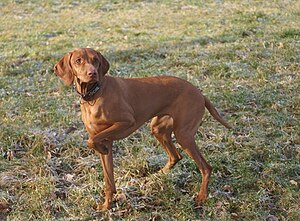Short-haired Hungarian pointing dog
| Short-haired Hungarian Pointing Dog (Magyar Vizsla Shorthair) | ||
|---|---|---|
|
|
||
| FCI Standard No. 57 | ||
|
||
| Origin : | ||
| Alternative names: |
Rövidszőrű magyar vizsla |
|
| Withers height: |
Males 58–64 cm, |
|
| List of domestic dogs | ||
The short-haired Hungarian Pointing Dog ( Hungarian Rövidszőrű magyar vizsla ) is a breed of dogs recognized by the FCI ( FCI Group 7, Section 1.1, Standard No. 57 ). As a pointing dog , the breed belongs to the hunting dogs .
Origin and history
The breed Magyar Vizsla ( in phonetic transcription [ ˈmɒɟɒr ˈviʒlɒ ] (Hungarian), / ˈmɑdjɑr ˈviʒlɑ / (simplified)) emerged at the beginning of the 20th century. However, the Magyars already brought such a type of dog with them from Asia when they were in 9./10. Populated the Carpathian Basin in the 19th century . The golden color has the purpose of a camouflage color in the steppes and grain fields. The ancestors of this breed of dog disappeared more and more in the 19th century when pointers , setters and pointing dogs became fashionable. Around 1920 the old type of hunting dog was remembered and the population began to be registered. On May 29, 1920, the "Hungarian Vizsla Breeders Association" was founded, which looks after this dog in breeding. In 1936 the breed was recognized by the FCI. After further setbacks from the world wars, the Vizsla gained more and more fans. Meanwhile, the breed stocks are secured. Around 150 puppies are born in Germany each year. Another Vizsla breed was developed through crossbreeding with Deutsch Drahthaar . The Hungarian Wirehaired Pointing Dog has been recognized by the FCI since 1965.
description
The males are 58–64 cm high and the bitches 54–60 cm. The body is muscular but narrow. The short-haired Magyar Vizsla comes in all color nuances from bread yellow to dark gold. Small (5 cm) white markings on the chest are accepted. However, spotted fur is undesirable. The color of the medium-sized eyes is matched to the color of the coat, usually never pungent or cold. However, like many other hunting dog breeds, darker eyes are preferred to noticeably light eyes. The ears are set low, hang down close to the cheeks and are rounded at the bottom. The lips are close-fitting, never drooping. Wattles ( dewlaps ) are undesirable. The tail is carried horizontally when moving. In Germany, docking the rod is permitted under the condition of hunting guidance, otherwise prohibited by the Animal Welfare Act.
Essence and use
The Magyar Vizsla is used universally for hunting, it is an excellent bloodhound , likes to retrieve with a soft catch , it combines the advantages of a sighthound , endurance and speed, with track and track security. He is extremely willing to learn. His philanthropy, sensitivity and devotion forbid keeping them in kennels. With sufficient employment it can be kept as a family dog .
The Magyar Vizsla is a very sensitive dog who cannot tolerate rough treatment in upbringing, training and keeping. His need for physical contact is extremely pronounced, he literally does not leave the side of his caregiver. A Vizsla needs adequate and species-appropriate employment. This is on the one hand hunting and on the other hand there are various possibilities in rescue dog work or dog sports such as tracking , mantrailing or agility . In addition to exercise and exercise, the Magyar Vizsla needs appropriate mental exertion. An underload can lead to behavior problems.
maintenance
The coat of the short-haired Magyar Vizsla is largely self-cleaning and requires little maintenance. When kept in a species-appropriate manner, there is no need to cut the claws.
Health
A special disease of the Vizslas is the so-called Vizsla myositis . The disease weakens the bite muscles, causing problems swallowing and vomiting foam.
Web links
Individual evidence
- ↑ a b c Breed Standard No. 57 of the FCI: Short-haired Hungarian Pointing Dog (PDF)
- ↑ "It should be noted here that the Vizsla - like every other breed of dog - is prone to various diseases. Myositis weakens the bite muscles. This leads to problems swallowing and vomiting of foam. The result can be difficult food intake." http://www.berliner-vizsla.de/
- ↑ Foale et al., BSAVA 2008 and Haley et al., ACVIM 2009 http://www.veterinary-neurologist.co.uk/Vizsla_Polymyosits/
